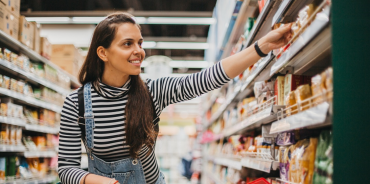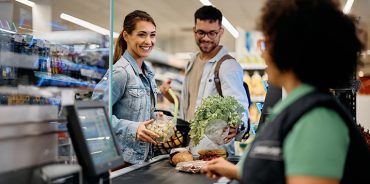Six ways Retailers and Brands can encourage Sustainable Behaviour
With world leaders about to gather in Scotland for the United Nations Climate Change Conference (COP26), dunnhumby’s Senior Consumer Psychologist, Feroud Seeparsand, looks at how easy it is to apply behavioural science to encourage sustainable customer behaviour in the grocery sector.
These applications can be applied to almost any sustainable behaviour whether it be increasing recycling or decreasing food waste. What follows are my top six favourite applications of consumer psychology to help directly or indirectly lower carbon footprints.
- The Classic Social Norm
In the UK, WRAP recently demonstrated how communicating social norms boosted an already high recycle rate by an additional 5% (from 86% to 91%)1. In collaboration with Unilever’s Radox brand and retail pharmacist Boots, the nudge simply consisted of a sticker on shower gels that stated on front of pack “Most people recycle me” together with a recycle logo.
The test and control study also found in a post-trial survey that respondents claimed the reason for increased recycling was due to the message.
- Dynamic Social Norms
However, whilst recycle rates are already high in the UK, other behaviours are still a minority, like eating a meat-free lunch. How can a nudge work in this context? A well-known US study2, found that highlighting a trend may be enough to nudge customers to become a part of that trend.
When comparing a static social norms nudge (of “30% of Americans limit their meat consumption…”) to a dynamic norm (of “over the last five years, 30% of Americans have started to make an effort to limit their meat consumption”), meatless lunches doubled in a university café. Meatless lunch orders in the dynamic norms condition was 34%, where for the static norms condition had 17% (the control group was 21%).
In another university café (this time in Germany)3, the dynamic norm message of “more and more customers are switching from to-go-cups to a sustainable alternative. Be part of this movement and choose a reusable mug”6 was used to promote reusable alternatives by 17.3%. This was based on a pre and post intervention study, over a 14-week intervention period in one café.
- Indulge Me
Particular words provide certain associations. So describing a meat free dish as “healthy”, may provide associations of being “less tasty” or “less satisfying”.
In a test vs control study in a US university café study found that indulgent descriptive may be a better method than a healthy description4. For example, “Twisted citrus-glazed carrots” was more likely to be selected from a menu when compared to “Carrots with sugar-free citrus dressing”. Likewise, “Dynamite chili and tangy lime-seasoned beets” fared better than “Lighter-choice beets with no added sugar”. Results found diners were 41% more motivated to choose an “indulgent vegetable” compared to its “healthy” alternative, even though there was no difference in the preparation.
Whilst there are some customers who may be on the lookout for healthy options, clearly many are not.
- Size matters
Given customers are more able to regulate their consumption at the point of purchase than at the point of consumption why not simply downsize a portion at the point of purchase? This can reduce both food waste and meat consumption at the same time.
Over a period of one month, a Belgian retail store was used as a test bed (against eight control stores)5.
The standard size of sausage was 150g, the new smaller and healthier portion which met Belgian guidelines was 100g and another medium size of 125g was also introduced. The price per weight was kept the same for each size. Furthermore, the assortment was arranged horizontally from small to large. The receipts were collected from those who bought the relevant products.
Results showed 52% of customers bought the new smaller two portions of sausage (26% for both the 100g and 125g). The remaining 48% bought the standard size. This led to 13% less meat being purchased. Receipts indicated that customers did not make more purchases from elsewhere in the meat category.
- Integrate, Don’t Segregate
There has been much discussion about where plant-based meats should be placed (i.e. with the meat category or in their own plant based bay). The Institute of Grocery Distribution did an implicit reaction time study which suggested customers would prefer to see plant-based meats with the meat category6.
They also report how Tesco (UK) trialled a move of 10 meat alternative products from the plant-based aisle to meat category. This resulted in an increase in sales over a 21-week period in 10 large stores (compared to ten matched control stores). Furthermore, Kroger (US) in a larger trial of 60 stores, in a 12 week trial, also found sales increased by 23%.
However, there is a note of caution of how vegans and vegetarians needed to be guided to the meat category via floor stickers and shelf barkers to inform the customer of store changes.
- Total Impact
Last but far from least, is the first real time web-based tool targeting sustainable food shopping behaviour called Envirofy7. Based on the Behaviour Change Wheel (see previous BCW blog8), this browser uses Education, Training and Environmental Restructuring to nudge the customer towards a lower Total Environmental Impact (TEI).
This is done by extracting Ingredients, Produce of, Recycling information, Food production, Packaging lifecycle and Transport from the shopping basket. Envirofy uses a four-tier traffic light system and presents the lesser TEI items at the top. It also states how many trees need to be planted to offset the current basket and uses motivational messages.
Localise, don’t just globalise
There is a bee in my bonnet when it comes to how sustainable behaviour is communicated. Whilst some customers may have universalist values and care about the other side of the planet (e.g. the rainforests of Borneo). For many, this is too physically and psychologically distant9. Therefore, the challenge is to communicate how climate change is affecting customers locally. In other words, retailers need to localise and not just globalise the effects of climate change.
To summarise, there are several proven ideas from consumer psychology that that can be used to prompt greater sustainable behaviour from customers. Whilst these ideas appear fun, simple and exciting, they can have some real-world benefits for us all.
References
2 Sparkman, G. and Walton, G.M. (2017). Dynamic Norms Promote Sustainable Behavior, Even if It Is Counternormative. Psychological Science 28(11) 1663-1674
3 Loschelder, D.D., Siepelmeyer, H., Fischer, D., Rubel, J.A. (2019). Dynamic Norms Drive Sustainable Consumption: Norm-based Nudging Helps Café Customers to Avoid Disposable To-Go-Cups. Journal of Economic Psychology 75: 102146–102160
4 Turnwald, B.P., Boles, D.Z., Crum, A.J. (2017). Association between indulgent descriptions and vegetable consumption: twisted carrots and dynamite beets. JAMA Intern. Med. 177 (8): 1216-1218.
5 Vandenbroele, J.; Vermeir, I.; Geuens, M.; Slabbinck, H.; Kerckhove, A.V. (2019) Nudging to get our food choices on a sustainable track Proceedings of the Nutrition Society 78: 1–14.
6 igd.com
7 Shakeri, G. and Mccallum, C. (2021). Envirofy your Shop: Development of a Real-time Tool to Support Eco-friendly Food Purchases Online. In CHI Conference on Human Factors in Computing Systems Extended Abstracts (CHI ’21 Extended Abstracts), May 8–13, 2021, Yokohama, Japan. ACM, New York, NY, USA, 10 pages.
9 Spence A., Poortinga W., Pidgeon N (2012). The psychological distance of climate change. Risk Analysis 32: 957–72.
TOPICS
RELATED PRODUCTS
The latest insights from our experts around the world



